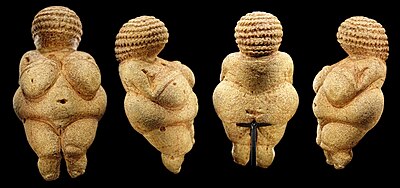Venus of Willendorf
The Venus von Willendorf is a Venus figurine from Gravettia discovered in 1908, around 11 cm tall and almost 30,000 years old . It can be seen as Austria's most famous find in the Natural History Museum Vienna .
Finding and describing
The Paleolithic figurine was on 7 August 1908 during construction work for Donauuferbahn in Willendorf in der Wachau by archeologist Josef Szombathy found ( location ). It was located at a depth of 25 cm in a soil of sand and ash. As early as 1910 it was considered "famous".
Further female statuettes were discovered at the same site in 1926, namely Venus II ( ivory , very poor state of preservation) and Venus III (ivory piece with traces of processing, classification as a Venus figurine disputed). They are assigned to layer 9, while more recent studies have shown that Venus I was 25 cm below layer 9 and was associated with a charcoal layer.
The archaeologist involved in the excavation, Josef Bayer , washed the figurine with water on the day it was found, so that traces of paint were erased, albeit not completely. When the first chemical tests were carried out in 1955, the figurine was already covered with shellac . Despite these impairments, it could be shown that the traces of color pigment were based on an iron oxide compound. An organic binder could not be found. Remnants of red chalk , which are partially visible to the naked eye , can still be detected in the head decoration . Originally the figurine was completely covered with red chalk, also called "red ocher"; It is unclear whether this painting was carried out permanently or only on certain occasions, or even exclusively for landfill. In 2007, the source material oolite was found , which is very likely to come from the Moravian deposit of Stránska Skála.
The sculpture is not made of limestone , as was long assumed , but of the aforementioned oolite, a sedimentary rock. It is around eleven centimeters high. It represents a naked, symmetrical female figure. One face is missing. The head is large, wears a hairstyle or headgear, and sits on narrow shoulders. The hairstyle or headgear was created by inclined lines and horizontal, concentric lines. The arms are thin and lie on the heavy breasts; they are surrounded on both sides by recessed lines, as are the hands, which make them appear more clearly emphasized. The fingers of the right hand are shown as separated from each other by long incisions. Incisions on the wrists suggest jagged bracelets. The breasts are also surrounded by lines.
The hips are strong, the abdomen protrudes, the buttocks are pronounced. The chest, stomach and thighs are modeled with deep, vertical engravings. The navel forms a natural depression in the stone that has been expanded on both sides. The legs are designed close to nature, but shortened, the feet are missing. The border to the buttocks is formed by two clear incisions that are not smoothed. The sexual characteristics are shown in detail. An incision is made on the thigh.
The exact way in which Venus was made is not known. The still visible traces of work indicate that at least the finishing was done with a burin . Such tools were found in layers 8 and 9, between which Venus was discovered.
Dating
On the basis of radiocarbon dating , the sculpture was given a time of around 25,000 years ago. According to measurements from 2014, the youngest culture layer KS9, over which the Venus von Willendorf was found, is dated to 24,900 years (14C) calBP, which is 27,150 to 26,850 years BC. Corresponds to.
material
The limestone from which Venus was made is an oolite , also called "egg stone". It is composed of tightly packed ooids 0.3 to 1 mm in size. The space between the ooids consists of sparitic calcite cement . Unlike many oolites, this one does not contain fossils. The material corresponds exactly to the oolithic limestone from Stránská skála, 136 km away (near Brno in Moravia ). Since some of the flint stones used for tools come from the same find layer, the origin of the stone from this location is considered to be relatively certain. Since Venus is the only Willendorf artefact made from oolite, the location of its manufacture remains speculative.
classification
Similar female idols made of limestone, soapstone or ivory, also made of clay , have been found over a wide distribution area from Europe to Siberia ; by 2008 over 200 specimens were known. Comparable finds in the vicinity of Willendorf are the Venus from Dolní Věstonice (Moravia) or the Venus from Moravany from Moravany nad Váhom in Slovakia .
It was assumed that there was a uniform religious concept during the late phase of the Gravettian period, i.e. before the climax of the last Ice Age , when there was already a lack of food and the population density declined. At the end of this phase 20,000 years ago, Central Europe was completely abandoned by Homo sapiens . Only thousands of years later was Europe repopulated by a smaller population who inhabited the caves with completely different cultural expressions. The Venus figures were gone.
exhibition
The original is considered so precious that only one copy was on display in the museum for a long time. The original Venus was shown to the public for the first time at an exhibition in 1998 in Schönbrunn Palace . On the occasion of the 100th anniversary of the find (but two months beforehand) it was shown in the Lower Austrian State Museum and on the anniversary itself at the place where it was found. It will then be exhibited again in the vault showcase set up during the recent renovation of the Natural History Museum. The high-security showcase at the site has been displayed every year since 2010 with works by contemporary artists who deal with the range of topics related to Venus.
Trivia
At the end of 2017, Facebook classified photos of the Venus von Willendorf that a Facebook user had shared as pornography and censored them. The company later apologized and announced that there was an exception for statues.
100 years after the discovery in 2008 by the Austrian Post a lenticular image - stamp issued with a nominal value 3.75 euro. When the 3D mark is tilted to the right and left, the image impression of a three-dimensional object appears.
See also
literature
- Philip R. Nigst: Willendorf II , in: Hugo Obermaier - Society for Research into the Ice Age and the Stone Age eV , 55th conference in Vienna , Erlangen 2013, pp. 59–66 (history of finds, stratigraphy).
- Lois Lammerhuber (photographs); Walpurga Antl-Weiser and Anton Kern (text): Venus. Edition Lammerhuber, 2013, ISBN 978-3-901753-08-4 (photo book for the 100th birthday of the discovery of Venus von Willendorf, with an essay in German / English).
- Alexander Binsteiner : Riddle of the Stone Age between the Danube and the Alps (= Linzer Archaeological research . No. 41 ). Magistrat der Landeshauptstadt Linz, Linz 2011, ISBN 978-3-85484-440-2 (92 pages).
- Walpurga Antl-Weiser: The wife of W. - The Venus of Willendorf, her time and the story (s) around her discovery . Verlag des Naturhistorisches Museum, Vienna 2008, ISBN 978-3-902421-25-8 .
- Johannes-Wolfgang Neugebauer : In order to find the Venus of Willendorf (= Archeology in Austria . No. 7.2 ). 1996, p. 4-9 .
- Wilhelm Angeli: The Venus of Willendorf . Edition Wien, Vienna 1989, ISBN 3-85058-035-0 .
- E. Drössler: The Venus of the Ice Age. Leipzig 1967.
Web links
- The Venus of Willendorf - website with numerous excellent photographs of the sculpture
- Entry on Venus von Willendorf in the Austria Forum (in the AEIOU Austria Lexicon )
- Entry on Venus von Willendorf in the Austria forum
supporting documents
- ^ Review of the book Venus , accessed June 19, 2011.
- ^ Fritz Wiegers, C. Schuchhardt: The development of diluvial art with special consideration of the representation of the human being , in: Zeitschrift für Ethnologie 46,6 (1914) 829-865, here: p. 829.
- ^ Walpurga Antl-Weiser: The anthropomorphic figurines from Willendorf , in: Wissenschaftliche Mitteilungen aus dem Niederösterreichisches Landesmuseum 19 (2008) 19–30.
- ↑ Walpurga Antl-Weiser: The wife of W. The Venus von Willendorf, her time and the story (s) of her discovery , Vienna 2008, pp. 108–111.
- Jump up ↑ Philip R. Nigst, Paul Haesaerts, Freddy Damblon, Christa Frank-Fellner, Carolina Mallol, Bence Viola, Michael Götzinger, Laura Niven, Gerhard Trnka, and Jean-Jacques Hublin: Early modern human settlement of Europe north of the Alps occurred 43,500 years ago in a cold steppe-type environment. PNAS October 7, 2014 111 (40) 14394-14399; first published September 22, 2014 https://doi.org/10.1073 /pnas.1412201111. Edited by Richard G. Klein, Stanford University, Stanford, CA, and approved August 28, 2014.
- ↑ Venus von Willendorf - a Czech woman , Spektrum.de, April 10, 2008.
- ^ Transports in the Ice Age: The Venus of Willendorf , faz.net, accessed on February 26, 2015.
- ^ Matthias von Schulz: Chubby from the ice . In: Der Spiegel , April 14, 2008, pp. 152 ff. (Online); Retrieved June 20, 2016.
- ↑ The Riddle from the Stone Age , orf.at, accessed on August 7, 2008.
- ↑ Facebook asks Deutschlandfunk Nova to apologize for censorship on March 2, 2018
- ↑ Facebook censored “Venus von Willendorf” on Deutsche Welle on February 28, 2018
- ↑ Venus von Willendorf 3D austria-forum.org, created September 16, 2009, changed September 29, 2019, accessed January 31, 2020.






